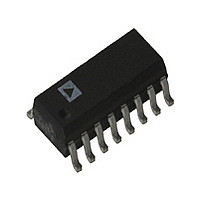AD7742BR Analog Devices Inc, AD7742BR Datasheet - Page 11

AD7742BR
Manufacturer Part Number
AD7742BR
Description
Manufacturer
Analog Devices Inc
Datasheet
1.AD7742BR.pdf
(12 pages)
Specifications of AD7742BR
Converter Function
VFC
Full Scale Frequency
2750
Power Supply Requirement
Single
Single Supply Voltage (typ)
5V
Single Supply Voltage (max)
5.25V
Single Supply Voltage (min)
4.75V
Dual Supply Voltage (typ)
Not RequiredV
Dual Supply Voltage (min)
Not RequiredV
Dual Supply Voltage (max)
Not RequiredV
Operating Temperature (min)
-40C
Operating Temperature (max)
85C
Operating Temperature Classification
Industrial
Package Type
SOIC N
Lead Free Status / Rohs Status
Not Compliant
Isolation Applications
In addition to analog-to-digital conversion, the AD7741/AD7742
can be used in isolated analog signal transmission applications.
Due to noise, safety requirements or distance, it may be neces-
sary to isolate the AD7741/AD7742 from any controlling
circuitry. This can easily be achieved by using opto-isolators,
which will provide isolation in excess of 3 kV.
Opto-electronic coupling is a popular method of isolated signal
coupling. In this type of device, the signal is coupled from an
input LED to an output photo-transistor, with light as the con-
necting medium. This technique allows dc to be transmitted, is
extremely useful in overcoming ground loops between equip-
ment, and is applicable over a wide range of speeds and power.
The analog voltage to be transmitted is converted to a pulse
train using the VFC. An opto-isolator circuit is used to couple
this pulse train across an isolation barrier using light as the
connecting medium. The input LED of the isolator is driven
from the output of the AD7741/AD7742. At the receiver side,
the output transistor is operated in the photo-transistor mode.
The pulse train can be reconverted to an analog voltage using a
frequency-to-voltage converter; alternatively, the pulse train can
be fed into a counter to generate a digital signal.
The analog and digital sections of the AD7741/AD7742 have
been designed to allow operation from a single-ended power
source, simplifying its use with isolated power supplies.
Figure 12 shows a general purpose VFC circuit using a low cost
opto-isolator. A +5 V power supply is assumed for both the
isolated (+5 V isolated) and local (+5 V local) supplies.
REV. 0
IN
+5V
AD774x
V
DD
GND1
Figure 12. Opto-Isolated Application
f
OUT
R
ISOLATION
BARRIER
OPTOCOUPLER
V
CC
GND2
–11–
Power Supply Bypassing and Grounding
In any circuit where accuracy is important, careful consideration
of the power supply and ground return layout helps to ensure
the rated performance. The printed circuit board housing the
AD7741/AD7742 should be designed so the analog and digital
sections are separated and confined to certain areas of the board.
To minimize capacitive coupling between them, digital and
analog ground planes should only be joined in one place, close
to the DUT and should not overlap.
Avoid running digital lines under the device as these will couple
noise onto the die. The analog ground plane should be allowed
to run under the AD7742 to avoid noise coupling. The power
supply lines to the AD7742 should use as large a trace as pos-
sible to provide low impedance paths and reduce the effects of
glitches on the power supply line. Fast switching signals like
clocks should be shielded with digital ground to avoid radiating
noise to other parts of the board and clock signals should never
be run near analog inputs. Avoid crossover of digital and analog
signals. Traces on opposite sides of the board should run at
right angles to each other. This reduces the effect of feedthrough
through the board. A microstrip technique is by far the best but
is not always possible with a double-sided board. In this tech-
nique, the component side of the board is dedicated to the ground
plane while the signal traces are placed on the solder side.
Good decoupling is also important. All analog supplies should
be decoupled to GND with surface mount capacitors, 10 F in
parallel with 0.1 F located as close to the package as possible,
ideally right up against the device. The lead lengths on the by-
pass capacitor should be as short as possible. It is essential that
these capacitors be placed physically close to the AD7741/AD7742
to minimize the inductance of the PCB trace between the ca-
pacitor and the supply pin. The 10 F are the tantalum bead
type and are located in the vicinity of the VFC to reduce low-
frequency ripple. The 0.1 F capacitors should have low Effec-
tive Series Resistance (ESR) and Effective Series Inductance
(ESI), such as the common ceramic types, which provide a low
impedance path to ground at high frequencies to handle tran-
sient currents due to internal logic switching. Additionally, it is
beneficial to have large capacitors (> 47 F) located at the point
where the power connects to the PCB.
AD7741/AD7742




